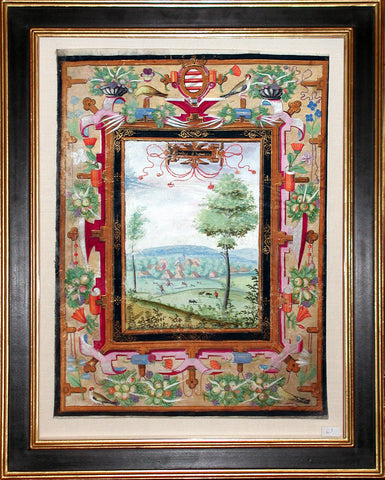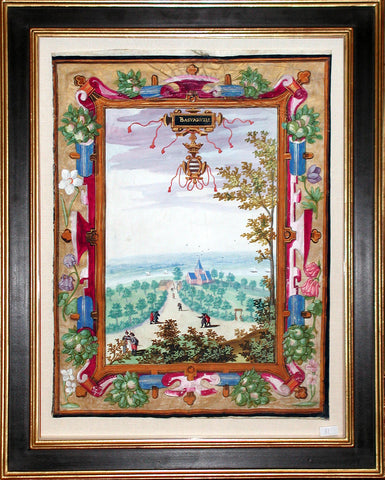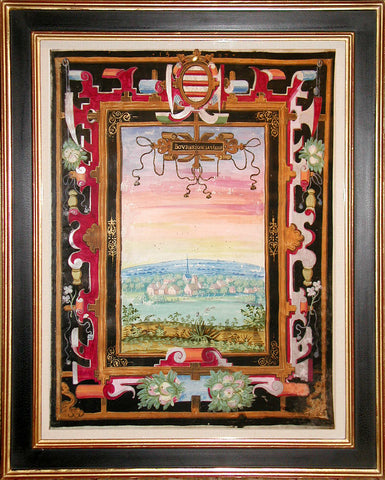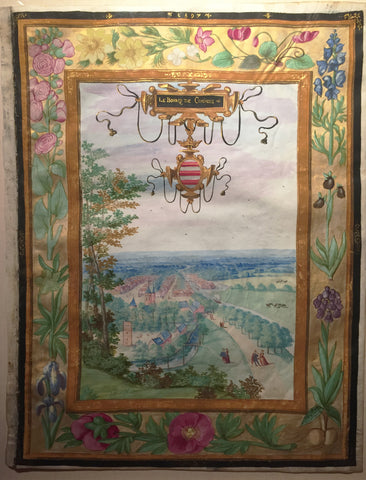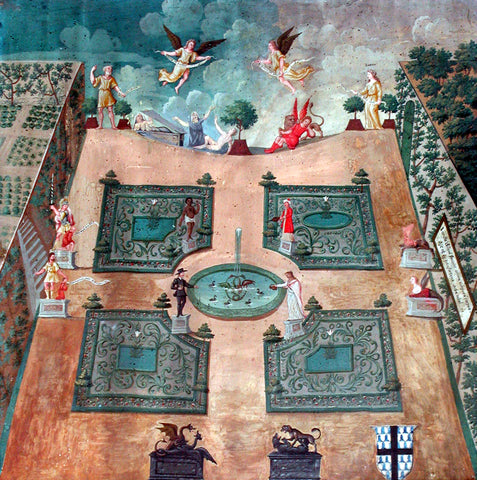
French School, (17th Century), An Allegorical Garden
French School, (17th Century)
An Allegorical Garden
Gouache on vellum with a contemporary frame
Frame size: 23 1/4 x 23 1/8 in
This elegant work, which marvelously showcases the beauty of the French garden, also provides an accurate image of how gardens in seventeenth-century Europe were laid out. The garden comprises of a square divided into four equal parts and two perpendicular alleys. Four figures on pedestals and four parterres, each containing a set of prized tulips, enclose a circular fountain situated at the garden’s central point. At the entrance of the garden are two plinths each supporting sculptures of a dragon and dogfighting. The garden proper is surrounded on its left by a vegetable garden and on its right by a park. The distinctive layout of this garden, inspired by Hadrian’s Villa at Tivoli, first gained widespread popularity in Italy during the period of the Renaissance.
However, this painting is more than just illustrative of seventeenth-century garden design but also contains an allegorical message, that of unity and resurrection. This directly relates to the coat-of-arms, located at the lower right, of the Brenas family, most probably the patrons of the work and who have lived in Velay since the tenth century. Their devise reads: O crux, ave, spes unica (O Cross, take leave, unite good).
In the left background of the composition is a male figure with the allegorical name, IUGO, who carries a standard bearing the inscription: Ad iudicaire venit (“He will be judged”). At the right of this personage is a female figure intended to represent EUDEM, and carrying a banner upon which is written: Terribilis dies iste (“Terrible is this day”). Between these two upright figures, whose names together signify “Under the same yoke,” are four additional figures. The leftmost of these figures is a woman who raises a slab on a tomb. Beside her is a man with his hands outstretched to heaven. Next to this figure is a nude male symbolizing a contemporary Adam. He rests against the side of a small tree. To the far right of these three individuals are a lion and a man dressed in a red tunic. In the upper portion of the composition, the sky is used to denote the transition between night and day. Within the sky are two angels carrying banners stating: Gloria in excelsis deo (“Glory to God in Heaven” and Et in terra pax hominibus (“And on earth peace to all men”).
This painting directly relates to two allegorical works in gouache of the same time and the same format: The Grotto and The Fountain, studied by Philippe Audoin in an article entitled “Clavicules” (L’Oeil, October 1968, no. 178, pp.14-19). One finds the same ochre tone of the earth and green of the vegetation, the pool of water, the blue and cloudy sky, as well as the small allegorical figures, finely drawn. The author of the article insists that the symbolism is of alchemy in these gouaches.
Key inspirations to the author of this allegorical garden were also the hermit paintings attributed to Nicolas Flamel (1330-1410). This legendary alchemist constructed the famed Massacre of the Innocents in 1407, an ornate arcade containing numerous symbolic figures. In 1659, Pierre Arnauld de la Chevalerie published a description of the work, The Hieroglyphic Figures of Nicolas Flamel, though the actual text is attributed to Flamel himself. Salmon reproduced the text in 1672 as Volume I of the Alchemy Library.
Direct correspondences exist between Flamel’s figures and the figures deployed in this allegorical garden. For example, Saint Peter, holding a key in his hand, is located at the middle of the fence to the garden’s left. Next to him, a kneeling female, clothed in orange, carries a banner stating: Propitius esto mihi Domini (“Lord, look upon me favorably”). At the left of the composition, Saint Paul is also depicted in a robe of white and orange edged in gold, holding a sword in the air. At his feet is a male figure with a standard stating: Dele mala quae feci (“Destroy the harm that I have done”). The two-hybrid creatures (one of which has the look of a siren) are located on the fence to the right of the work. They bear an inscription reading: Iuncta simul faciunt unum corpora corpus (“the joints of the body are assembled to make one body”) and: Sic est in toto fortius orbe nihil (“There is nothing more strong on all the earth”). This idea of union or fusion is symbolically echoed by the two serpents, themselves entwined in the center of the fountain. As for the four central figures, each of them represents alchemy itself, along with the four continents of the world: Europe, Asia, Africa, and America.
Please feel free to contact us with questions by phone at 215.735.8811,
or by email at loricohen@aradergalleries.
We Also Recommend

